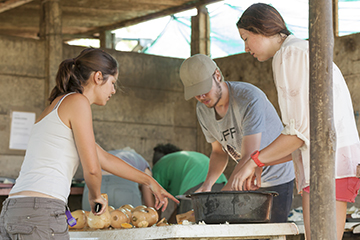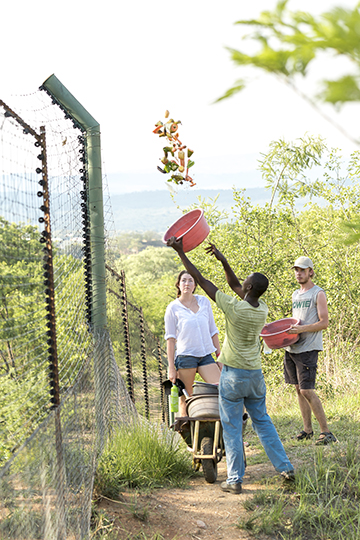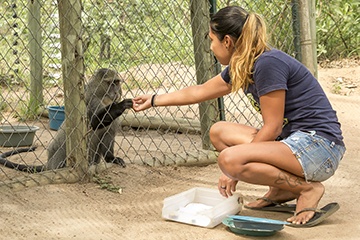Primates and Tourism:
How to Be a Responsible Primate Tourist
Planning your post-pandemic travel? Visiting your favorite primate species can be a great way to contribute to their conservation while having an amazing experience.
by Jenny Botting
In recent years, wildlife tourism, sometimes called ecotourism, has played an increasingly large role in many countries’ travel industries and primates are often a star attraction. Every year, thousands of people go on tours and trips to visit primates in many different countries, from trekking with mountain gorillas in Rwanda, to spotting spider monkeys in Mexico. Wildlife tourism is an important source of income for many countries, but the COVID-19 pandemic has led to the near-total suspension of international tourism and has had a devastating effect on many projects and sanctuaries. While it’s not yet safe to wander, many people are looking forward to a future when we can once again travel for leisure. So, for all primate enthusiasts planning your post-pandemic travel, visiting your favourite primate species can be a great way to contribute to their conservation while having an amazing experience. However, wildlife tourism experiences can vary in nature and it’s important that, when we are able to travel once more, we do it as responsibly as we can.
The pros and cons of wildlife tourism
First of all, we must ask a crucial question – is tourism actually beneficial for primates and the communities living adjacent to them? It turns out that the answer is pretty complicated. On the surface, tourism has the potential to provide financial benefits to communities living alongside primates and thus help incentivise their protection. There are some tourist operations, such as the well-known Mountain gorilla tourism in Rwanda, that have proven excellent models of how tourism can be beneficial to both local communities and primates. However, this model is not universal and there are also a number of negative impacts that tourism may have on primate populations. These include potential habituation of primates to humans, which can increase primates’ susceptibility to poaching, human-wildlife conflict and disease transmission between humans and primates. Additionally, economic incentives may overtake conservation as the driving force behind the projects and it is possible that the economic benefits of wildlife tourism may not reach local communities. In the end, each individual tourism operation has unique implications for the primate populations that they visit and their neighbouring communities. So, as tourists, it is important to do our homework to ensure that our choices benefit both local communities and conservation initiatives.
Visiting wild primates
There are different ways to engage in primate tourism, but one of the most popular is to visit free-ranging primates in their natural habitats. In many places, COVID-19 has put a stop to people visiting primates in the wild, as primates, and especially great apes, are highly susceptible to human respiratory illnesses, including the new coronavirus. If wild apes were to be infected with this virus from humans, it could decimate whole populations of endangered species, as has tragically been seen with outbreaks of Ebola. Once it is safe to visit again, there are a huge number of options to visit primates in their natural habitats, from capuchins in Costa Rica, to baboons in Botswana. This can be an amazing experience and can be a great way to make sure your vacation money goes towards conserving wild primates.
The International Union for Conservation of Nature (IUCN) published guidelines for tourism with great apes, including limiting the viewing groups to a maximum of four tourists visiting once a day, wearing masks, and maintaining a distance from the animals of at least 7 metres (22 feet) at all times. It is essential that we abide by the regulations to protect the primates’ health and safety. When planning a trip, look for tour operators that strongly enforce the safety regulations and that don’t advertise with photographs of unmasked tourists very close to, or interacting with, primates.
Some operators also offer trips to see ex-captive, reintroduced primates in the wild. This is likely because they are more habituated to humans and therefore sightings are more likely. However, the negative effects of tourism can be even greater for these animals. Since they are already habituated to humans, they may come too close to tourists, putting both tourist and primate at risk, and forgo a normal daily routine in order to wait for food from visiting humans. Sadly, this may hinder their ability to readjust to life in the wild. In general, it is best to avoid sites that operate tourism with reintroduced, ex-captive apes.
Visiting wildlife centres
Another great way to see primates up close and support primate welfare and conservation efforts is to visit a sanctuary, such as those that are PASA members. Many sanctuaries, such as Chimp Eden in South Africa and Chimfunshi Wildlife Orphanage in Zambia offer guided tours of their facilities to visitors, allowing them to learn about the primates and the work of the centre, while your entry fee helps support the sanctuary’s vital work. Some sanctuaries, such as Ngamba Island in Uganda, or Tacugma Chimpanzee Sanctuary in Sierra Leone, also offer accommodation packages. This is a great way to visit the apes and learn about the local culture while supporting the running of the sanctuaries.
Some PASA member sanctuaries also welcome long-term volunteers to help support their vital work. Long-term volunteers can expect to help out with a variety of tasks, including construction, enrichment, diet preparation, and education. Volunteering at a sanctuary can be an amazing way to learn about primates, while actively contributing to their welfare and conservation. For more details on volunteering at a PASA sanctuary, click here.
Be sure to do your research before visiting a sanctuary. Unfortunately, in many countries, any captive facility may call themselves a sanctuary, but they may not all act in the best interest of the animals. Any facilities that allow tourists to touch, feed, or take selfies with primates are likely not a true sanctuary. This applies not only to primates, but to all other species as well. Look for accreditation by an organization like PASA as one way to ensure a high standard of animal care.
Encountering primates on your travels
Finally, remember that even if you do not intentionally set out to visit primates, if you travel in a primate-range country, you might find yourself encountering wild primates. While most people picture wild primates swinging through a forest canopy or running across the savannah, the reality of the modern world means many primate habitats have been modified by humans. Primates are now adapting to live in these human-dominated landscapes; for example, troops of langurs or macaques are a common sight in many cities in India, and vervet monkeys can often be seen foraging around beach resorts in South Africa . Wild primates often frequent tourist sites around Africa or Asia because of the opportunities they provide to gain easy access to human food. Human-primate interactions are complex and can differ in nature; even within the same area, some residents may appreciate the primates, whereas others may view them as pests. It’s important as a tourist to appreciate the primates, but not to encourage them in behaviours that may put them, or humans, in danger. These primates are likely to be very habituated to humans. They might approach you closely, or try to steal food from your hands, car, or room. Even if they approach you very closely, it’s important to never try to touch or feed wild primates. Remember to leave at least 7 metres, or 22 feet, between yourself and the primate, and don’t go closer to take photographs. Just stand back and admire them in all their beauty!
Know before you go
Hopefully it won’t be too long before we can all safely travel again. For when that day comes, below are some easy-to-follow guidelines that will help you plan an amazing primate tourism experience, while hopefully making a positive contribution to both local communities and primate conservation.
- Before booking a tour, ensure that the operators stick to strict health and safety protocols to protect both you and the primates you are visiting.
- Avoid ‘sanctuaries’ where you can pay to feed/touch/take selfies with animals.
- Don’t visit primates if you think you might be unwell.
- Try to choose tour operations run by, and benefitting, local communities.
- Avoid tour operators that visit ex-captive, reintroduced primates.

Volunteers prepare food for the monkeys at Vervet Monkey Foundation in South Africa.

Feeding time at Vervet Monkey Foundation.

Volunteering at a PASA member sanctuary is one way to practice ethical ecotourism.
